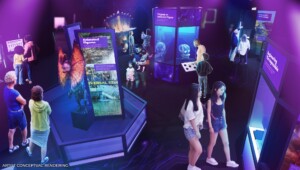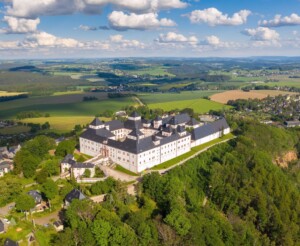Bletchley Park was, until recently, a carefully guarded secret kept secret.
Today, it is a heritage site which has undergone the first stages of a sympathetic Lottery-funded restoration to preserve the important story of the Codebreakers during WW2.
On May the 8th, the 70th anniversary of VE Day, the Trustees announced the masterplan for the next stage of development, which will be a major step towards its consolidation as a world-class heritage site, education centre and museum.
Iain Standen, retired Army Colonel and CEO of the Bletchley Park Trust, spoke to Blooloop about his  own background, and the process of leading the ambitious restoration project.
own background, and the process of leading the ambitious restoration project.
He has been CEO at the Park for three and a half years, and describes himself as a lifelong “keen amateur historian and battlefield guide”.
“So, having spent 28 years in the Army doing Army stuff of different sorts from communications intelligence, treaty planning and bits and pieces, it came time to leave and this job happened to come up at the same time. For me, it was a no-brainer to apply for it, having quite an interest in history; having worked in this sort of world in its modern guise; it was a story that fascinated me, and a really great opportunity. What attracted me as well as the history was the challenge of the place.”
The Bletchley Park Restorarion
As part of his selection process, he did a secret trip to the site to see what was going on, and realised the great potential of the place.
The Trust had just been awarded the Heritage Lottery grant, and as Standen took up his position received the Stage 2 confirmation of that grant.

From his arrival in January 2012, his initial brief was to drive the restoration project forward.
“We were half a million pounds short. We were lucky enough to be able to bag that in the first 6-8 weeks I was here. By Easter that year we had all the money; in the summer of 2012 we went through the commissioned start process with the HLF which was a matter of dotting the ‘i’s and crossing the ‘t’s, and in the autumn of ’12 we kicked off in earnest.”

The structural aims of the project were threefold.
First, there was the creation of a new visitors’ centre in Block C, a listed wartime building that had been completed in 1942, and held Hollerith punch-card sorting machines. It had been built for purpose, so was functional but had “…some interesting little quirks in terms of use, like acoustic tiles in the ceiling to stop the noise of machines echoing around it.”
Second, there was the restoration of the wartime huts. “Really, 2 ½ huts we restored, Hut 6 and Hut 3 which were virtually derelict, so we stopped them completely falling down, stabilised them and restored them. “
Hut 8, which had been restored some years ago, had a makeover, and some external work was done on Hut 1.

“These huts were all pretty much built at the start of the War with an expected lifespan of probably five years, so that’s seventy years over their expected life. They’re glorified garden sheds, for want of a better word: simple brick footings then pre-fabricated huts on the top. They were in desperate need of repair.”
The third element of the project was to restore Bletchley Park to the way it was in 1940-41.
“For example, if you’d come here 2 ½ years ago you’d have found a 1970s car park; now the mansion is set in the parkland of its heyday year. We’ve made the central park traffic-free, so there are new car-parks on the periphery etc which is just as well because on a weekday we’re getting 600 visitors, and at weekends we’re getting 1000-1500 a day.”
Storytelling is crucial to a Heritage museum
The next step was to dress the huts with period items.
There are immersive presentations in Huts 3 and 6, where visitors can wander at will rather than being separated from exhibits by a rope, completed with a combination of restoration and set dressing augmented by audio visuals. Projectors hidden in false filing cabinets throw images onto the walls, and an evocative soundscape by Peter Key runs through the huts, telling a story and lending background atmosphere.

“… so you might be in one room listening to a conversation; in another room you can hear a telephone ringing or a typewriter going. And the sound element is carried forward through the rest of the site. Round the parkland there are 20-odd sound-cones (external speaker systems) that play about a forty-five minute loop of sounds around the park, so there’s a motor-bike starting – a staff rider – down by the front gate; there are coaches coming in and out because transport is a key part of the story; by the bike shed you can hear the bicycle bells; go round the lake and you hear a couple having a chat because, you know, romance is part of the story; one that catches all the visitors out is a Spitfire that flies overhead: there are speakers up in the trees, and you hear this Spitfire go from left to right, and you see people all the time staring at the sky, trying to see the Spitfire.”
He adds, “That’s been a really, really good little add-on to the project. There’s a little side-story on that: when we went to tender for this part of the project I think we had about four contractors, and I was reading through the tender bids and I got to the third one and thought: ‘I’ve seen that name before.’ And, actually, three of the four contractors had the same sound guy. He’s the go-to bloke for doing this sort of stuff. So we were going to get Peter Key whichever contractor we were getting, and I can see why – he’s brilliant at putting these things together, so the sound is really immersive around the place, people get the feeling of what it was like.”

Bringing Bletchley to life – Sound & Vision
Chris Willrich of DJ Willrich, commissioned to install the atmospheric AV input, detailed his role in the reconstruction.
“Bletchley Park was the base for the secret operations of Codebreakers during the Second World War. The Introductory Exhibition in Block C lets visitors walk into a world from the past as a steam engine’s whistle sounds and the rattle of wheels on tracks marks the train’s departure. They have arrived in wartime Bletchley Park, where codes are cracked, secrets uncovered and cyphers decrypted. Projections and audio portray life when the Park was active, preparing visitors for their exploration of Bletchley Park.
The grounds of the Park are filled with the audio of the de-coders’ comings and goings, with the occasional break for pleasure or passing aircraft. Four of the huts have been restored and cunningly hidden speakers let visitors overhear conversations, while life-size projected images of workers ‘people’ the rooms, showing them at work and celebrating their successes.”
Willrich says, “My role in the project was to manage the AV hardware installation & commissioning as well as managing the project on behalf of DJW. So attending the meetings all the way through was key to making sure everything worked on opening day, something that could not have been done without the power of Medialon controlling the system.”

The installation was, however, far from straightforward, and Willrich outlined various obstacles and the measures that were taken to overcome them.
“The initial AV package included no show control, the plan was to have a volunteer walk around each morning and evening turning on each projector, computer and interactive. On being assigned to the project and going to the first project meeting I explained the power and benefit of putting in a control system and the Bletchley Park team decided it would be beneficial.
Listed buildings, grounds and even trees caused some rather large obstacles for the whole project team and installing speakers in grade 1 listed trees without damaging them proved a particular obstacle, of course, one that the DJW team overcame!”
He adds, “We also had a fantastic project team in Event communications (Design), The Hub (Fit-out), Elbow Productions (Media), Clay Interactive (interactives) and ISO (interactives).”
Medialon was the product and support team underpinning D J Willrich’s work.
“Medialon is well suited to being used on a project like Bletchley Park as the huts are fragmented and require different levels of control, from simply turn on/ turn off housekeeping to timed shows, lighting control and more. We were also able to give the staff at Bletchley Park varying levels of control by giving set web panels to different people. Duty managers have complete control over the entire AV installation from their smart phone, while the cleaning crews and maintenance staff can operate power control and lighting from the console in the rack room.”

The interpretation is based very much on the ‘people stories’.
Iain Standen took up the narrative, “Wherever you look, whether it’s on an interpretive board in the huts or an exhibition, the veterans’ memories are embedded. Virtually everywhere you go there are quotes . Veterans have been crucial to us. There were nearly ten thousand people working at the place and its environs at the height of the War; probably fifteen thousand people went through in terms of coming through and moving on to other jobs; we’re still in touch actively with about fifteen hundred at the moment, and they’ve been invaluable in terms of providing those human stories to populate the site. “
Over the course of the Trust’s 23-year history it has been collecting those memories and a rich variety of video and audio is incorporated into the interpretation wherever possible.
“So, for example, we have a multi-media guide that helps people around the site for those that want it, based on an iPod Touch platform; it’s got various stories, and many of them are illustrated by veterans’ memories, which help to bring the place alive for people.”

The core story, of course, is codebreaking
Part of the interpretation that was put out in one of the previously restored huts is a number of interactives that take people through some of the basic code-breaking techniques.
As with all museums, it is important to identify the audience and key themes, and to ensure that the interpretation is accessible to all. Standen expands on this, “Some of our story is quite complicated so in ‘toe-dippers, paddlers, swimmers and divers’ vernacular, top-line is about people just wanting to put a toe in it; then there’s a bit more detail in terms of paddling around; then in places there are deep dives.”
Much of the interpretation is geared towards a family audience. Most of the content, according to Standen, will engage the interest of children from 10-12 upwards. He adds, “We’ve still got a little bit of work to do on younger audiences, and we’re looking for our next stage of development to pick that up, though our multimedia guide helps: there’s an adult one and a complementary family one that engages the kids.
Public engagement is as much of a priority for a heritage museum as for any other attraction.
“Part of that is trying to get repeatability into our product, which is about keeping the content refreshed. We certainly do a lot of that, and we have plans now for the next ten years to put new stuff on and also to refresh what we’ve got.”

Bringing new audiences in is part of engaging with the public.
“For example, we recently put on an exhibition of props and costumes from The Imitation Game to run just as the film came out for a year (above). It was quite clear it was a whole new audience in there – Benedict Cumberbatch fans; the film fans who want to come and see his costumes or Keira Knightley’s costumes or indeed to see where the film was made: we were lucky in that they came here and filmed internal shots for about a week. So part of the challenge is about keeping it fresh and keeping new things for people to see.”
The Future
The future, Standen believes, is bright. Visitor numbers on the back of the project have risen.
“When I first arrived here in 2011 we had 120 thousand visitors; last year we had 195 thousand. Post the project launch – the Duchess of Cambridge officially opened it in June last year (below), we’ve experienced 40-45% growth. This year, we’re 82% up on the equivalent period last year, so we just breached 100, 000 visitors yesterday, and on that basis we’ll have over a quarter of a million visitors this year. I think we’ve moved from the third division to the second division. We’re not yet in the realms of Blenheim and the Nationals, but we are most certainly alongside Duxford.”

On the 8th of May, the 70th anniversary of VE Day, Bletchley Park unveiled the master plan which will be rolled out over the next ten years. It has five main elements, and will include the expansion of gallery and exhibition space and the creation of a new archive and an educational facility, as well as a variety of exhibitions and, “a big, multimedia aspiration we have for a big, central, go-to theme in the centre of the park which picks up the one big story: essentially, what difference did Bletchley Park make to the outcome of the War – what was Bletchley Park’s contribution.”
Bletchley Park hosted nine thousand children in 2014, and expects to get around thirteen thousand this year. With the completion of the planned education facility, the numbers will be in the region of twenty-five thousand.
Standen points out, “We have a story that’s unique. Most of our education programmes revolve around code-breaking in some shape or form as you’d expect, which is largely maths by stealth, and given the dearth of maths stuff at the moment, it’s something that people are crying out for.”
In conclusion, Standen adds, “We are hugely grateful to the National Lottery for the support. I think in terms of any heritage attraction these days you can’t do any of this without big wads of capital investment, even with the visitor numbers we’re talking about. We are more than self-sustaining in terms of our operating costs, but heritage is an expensive business, whether it’s putting on an interpretation or repairing and maintaining old buildings. Anything that is big and new requires capital investment, so we’re really pleased about the HLF project, and with our corporate sponsors. I think anybody in our field who isn’t looking at all those diverse markets to get capital in is probably not looking out for the future in the way they should be.”
The first stage of the restoration, completed last year, safeguarded Bletchley Park and its fascinating story for future generations. The implementation of the next stage will, it is believed, secure its status as a world-class heritage site.

All images ©ShaunArmstrong/ mubsta.com














